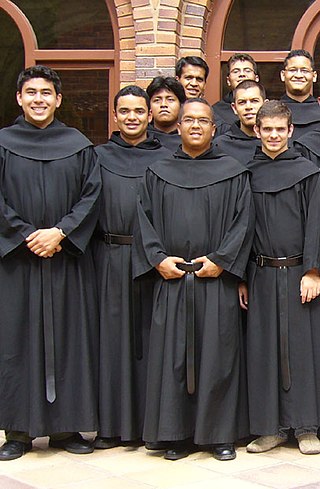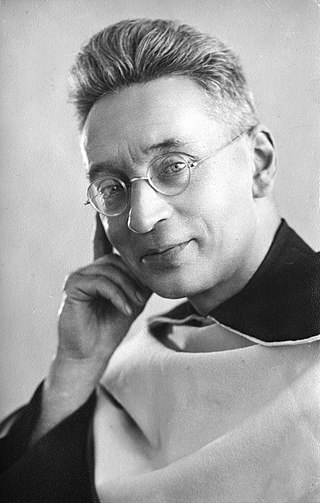
The Order of the Brothers of the Blessed Virgin Mary of Mount Carmel, known as the Carmelites or sometimes by synecdoche known simply as Carmel, is a mendicant order in the Catholic Church for both men and women. Historical records about its origin remain uncertain; it was probably founded in the 12th century on Mount Carmel in what is now Israel.

Teresa of Ávila, OCD, also called Saint Teresa of Jesus, was a Carmelite nun and prominent Spanish mystic and religious reformer.

St. John of the Cross was a Spanish Catholic priest, mystic, and Carmelite friar of converso origin. He is a major figure of the Counter-Reformation in Spain, and he is one of the thirty-seven Doctors of the Church.

A convent is an enclosed community of monks, nuns, friars or religious sisters. Alternatively, convent means the building used by the community.

A friar is a member of one of the mendicant orders in the Roman Catholic Church. There are also friars outside of the Roman Catholic Church, such as within the Anglican Communion. The term, first used in the 12th or 13th century, distinguishes the mendicants' itinerant apostolic character, exercised broadly under the jurisdiction of a superior general, from the older monastic orders' allegiance to a single monastery formalized by their vow of stability. A friar may be in holy orders or be a non-ordained brother. The most significant orders of friars are the Dominicans, Franciscans, Augustinians, and Carmelites.

Mount Carmel, also known in Arabic as Mount Mar Elias, is a coastal mountain range in northern Israel stretching from the Mediterranean Sea towards the southeast. The range is a UNESCO biosphere reserve. A number of towns are situated there, most notably Haifa, Israel's third largest city, located on the northern and western slopes.

The Scapular of Our Lady of Mount Carmel belongs to the habit of both the Carmelite Order and the Discalced Carmelite Order, both of which have Our Lady of Mount Carmel as their patroness. In its small form, it is widely popular within the Latin Church of the Catholic Church as a religious article and has probably served as the prototype of all the other devotional scapulars. The liturgical feast day of Our Lady of Mount Carmel, July 16, is popularly associated with the devotion of the Scapular.

Dialogues des Carmélites, FP 159, is an opera in three acts, divided into twelve scenes with linking orchestral interludes, with music and libretto by Francis Poulenc, completed in 1956. Poulenc wrote the libretto for his second opera after the work of the same name by Georges Bernanos, itself based on The Song at the Scaffold by Gertrud von Le Fort. This is a fictionalized version of the story of the Martyrs of Compiègne, Carmelite nuns who, in 1794 during the closing days of the Reign of Terror during the French Revolution, were guillotined in Paris for refusing to renounce their vocation.

The Third Order of Our Lady of Mount Carmel, also known as the Lay Carmelites, is a third order of the Carmelite Order of the Ancient Observance, established in 1476 by a bull of Pope Sixtus IV. It is an association of people who choose to live the Gospel in the spirit of the Carmelite Order and under its guidance. Its members are mainly lay people.

Our Lady of Mount Carmel, or Virgin of Carmel is a Roman Catholic title of the Blessed Virgin Mary venerated as patroness of the Carmelite Order.

Simon Stock, OCarm was an English Catholic priest and saint who lived in the 13th century and was an early prior of the Carmelite order. The Blessed Virgin Mary is traditionally said to have appeared to him and given him the Carmelite habit, the Brown Scapular. Thus, popular devotion to Stock is usually associated with devotion to Our Lady of Mount Carmel.

Crespi Carmelite High School, shortly known as Crespi, is a private Catholic all-boys four-year college preparatory high school located in Encino District, Los Angeles, California. It is part of the Roman Catholic Archdiocese of Los Angeles.

The Sisters of the Apostolic Carmel are members of a Carmelite religious institute dedicated to female education. It was founded in the latter part of the 19th century by Mother Veronica of the Passion, OCD, under the guidance of her mentor, Bishop Marie Ephrem of the Sacred Heart, OCD, who had envisioned the birth of "a Carmel for the missions" in India, devoted to teaching and education.

The Discalced Carmelites, known officially as the Order of the Discalced Brothers of the Blessed Virgin Mary of Mount Carmel or the Order of Discalced Carmelites, is a Catholic mendicant order with roots in the eremitic tradition of the Desert Fathers. The order was established in the 16th century, pursuant to the reform of the Carmelite Order by two Spanish saints, Teresa of Ávila (foundress) and John of the Cross (co-founder). Discalced is derived from Latin, meaning "without shoes".

Titus Brandsma was a Dutch Carmelite priest and a professor of philosophy. Brandsma was vehemently opposed to Nazi ideology and spoke out against it many times before World War II. He was imprisoned at the Dachau concentration camp, where he was murdered in 1942.

The Rite of the Holy Sepulchre, commonly called the Carmelite Rite, is the liturgical rite that was used by the Canons Regular of the Holy Sepulchre, Hospitallers, Templars, Carmelites and the other orders founded within the Latin Patriarchate of Jerusalem.
Prior is an ecclesiastical title for a superior in some religious orders. The word is derived from the Latin for "earlier" or "first". Its earlier generic usage referred to any monastic superior. In abbeys, a prior would be lower in rank than the abbey's abbot or abbess.
The Book of the First Monks is a medieval Catholic book in the contemplative and eremitic tradition of the Carmelite Order, thought to reflect the spirituality of the Prophet Elijah, honored as the Father of the Order.

The Secular Order of Discalced Carmelites, formerly the Secular Order of Discalced Carmelites of the Blessed Virgin Mary of Mount Carmel and of the Holy Mother Saint Teresa of Jesus, is a third order of Catholic lay persons and secular clergy associated with the Discalced Carmelites.

María de las Maravillas de Jesús, OCD, in some contexts known as Maravillas de Jesús, was a Spanish Discalced Carmelite. She founded several houses of her order and even set one up in India after serving a brief exile with other Carmelites due to the outbreak of the Spanish Civil War.














